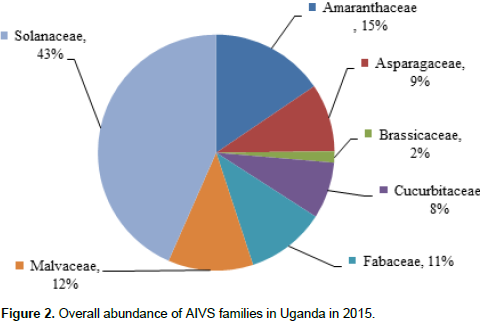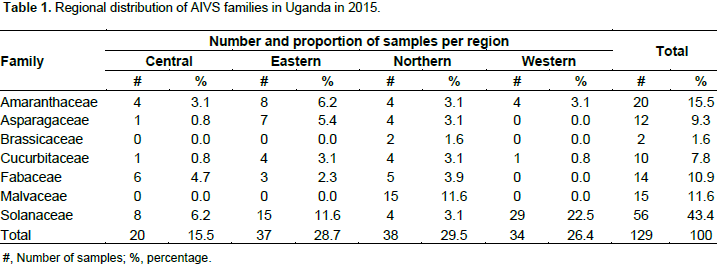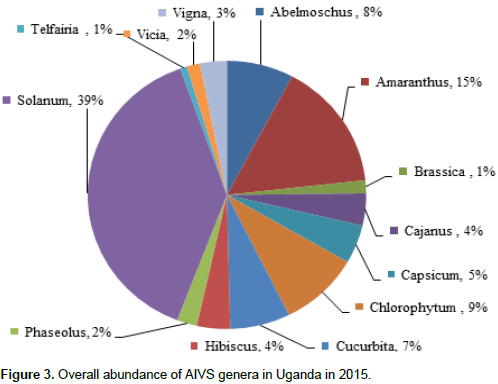ABSTRACT
African indigenous vegetable species (AIVS) provide a means of livelihood to many urban and peri-urban dwellers in Uganda. It was thus deemed necessary to understand the existing diversity and distribution of the traditional African vegetable species as a basis for recommending conservation and utilization strategies against biodiversity loss. A field survey was conducted in the four major agro-ecological zones of Uganda to provide information on a recent abundance of the various AIVS. Results from the survey showed that the Solanaceae (43.4%), Amaranthaceae (15.5%) and Malvaceae (11.6%) were the most prevalent families out of seven different families encountered. Twenty-three (23) species, a number lower than that initially reported in literature and distributed unevenly in the different regions were identified. Majority of the species were the indigenous rather than introduced vegetable species. Firstly, the study is informative of the superior importance of Solanaceous species compared to other AIVS. Secondly, the survey results indicate that the AIVS are becoming increasingly more important in Uganda than their introduced counterparts since all the 43.4% that composed the Solanaceae majority were of indigenous type. Research efforts should be devoted towards improved variety development and germplasm conservation to prevent a possible biodiversity loss of the most important AIVS for increased household incomes and nutrient security among the resource-poor majority in Uganda and other sub-Saharan Africa countries.
Key words: Crop biodiversity, germplasm collection, indigenous vegetables, species abundance.
African indigenous vegetable species (AIVS) are useful locally available resources for the achievement of food security and for poverty alleviation among smallholder farmers in rural, peri-urban and urban areas in sub-Saharan Africa (Abukutsa- Onyango, 2014; Ebert, 2014). AIVS can be defined as those vegetable species that either originated in Africa or have stayed on the continent for such a long time in history that they are now indigenized (Kamga et al., 2016; Syfert et al., 2016). The AIVS, also commonly referred to as traditional African vegetables are primarily either wild or semi-domesticated vegetable species that are accustomed to and integrated among the diets, habits and traditions of different African communities (Ebert, 2014; FAO, 2013; Ojiewo et al., 2013). The traditional African vegetables are thus categorized into two based on origin; indigenous and introduced depending on whether they originated on the continent or from outside Africa, respectively (Kamga et al., 2016; Syfert et al., 2016; Von Grebmer et al., 2015). In the past, the introduced vegetables were the only category canonically known as commercial vegetable species; and the indigenous for subsistence use (Cernansky, 2015; Ojiewo et al., 2013). Over the years, farmers in Africa have picked a commercial interest in the indigenous species and such a trend is on an optimistic rise (Abukutsa-Onyango, 2014; Ebert, 2014; FAO, 2013; Pincus, 2015).
The increasing commercial interest for AIVS brings hope for full utilization of these vegetables (Bisamaza and Banadda, 2017; Cernansky, 2015). The AIVS are reported to have higher levels of micronutrients and essential minerals as well as protein than the exotic or introduced vegetable species (Bisamaza and Banadda, 2017; Ojiewo et al., 2013; Pincus, 2015). The traditional African vegetables have thus been documented for multiple uses such as food, cash, medicinal, cultural and ornamental purposes (Abukutsa-Onyango, 2014; Ebert, 2014; Omulo, 2016). Other types of AIVS exist based on plant part used; mainly leafy, fruit, seed and root vegetables (Adeniji et al., 2012; Bationo-Kando et al., 2015; Borràs et al., 2015; Kouassi et al., 2014; Prohens et al., 2013). The most important AIVS in Uganda are consumed as leaves for instance Solanum aethiopicum ‘Shum group’, Amaranthus spp., Abelmoschus esculentus and Hibiscus sabdarifa (Omulo, 2016; Pincus, 2015). Elsewhere the fruit, seed and root vegetables are vitally important for food among other uses (Ebert, 2014; FAO, 2013).
There is a diversity of AIVS in Uganda such as amaranths (amaranths spp.), African eggplant (
S. aethiopicum), and pumpkins (
Cucurbita spp.) (
http://afri-sol.org) and African nightshades (Pincus, 2015). By the year 1989, at least 160 species of traditional vegetables were reportedly collected from 11 agroecological zones in Uganda (Abukutsa-Onyango, 2014; Ebert, 2014). The wide of range of AIVS is due to favorable agroclimatic conditions (Abukutsa-Onyango, 2014; FAO, 2013). Eight years later, a similar survey documented only 34 species which indicates a biodiversity loss of about 79% attributable mainly to human activity, bush fires and prolonged drought (Alexandratos and Bruinsma, 2012). The rapid decline in diversity of the species is detrimental as it compromises their potential contribution towards food security and livelihood of many rural and urban smallholder farmers (Agoreyo et al., 2012; Alexandratos and Bruinsma, 2012; Ayaz et al., 2015; Stone et al., 2011).
For example,
S. aethiopicum ‘Shum group’ is an important commercial and subsistence crop in mainly urban and peri-urban areas of central Uganda (Pincus, 2015). The food security value of the AIVS is mainly due to their higher nutrient content compared to introduced vegetables (Agoreyo et al., 2012; Ayaz et al., 2015; Chinedu et al., 2011). It was thus deemed necessary to provide an update on the biological diversity and distribution of the traditional vegetable species (
http://afri-sol.org/index.php/2016/09/15/launch-of-paepardfara-project2014-2017/). The specific objectives of this study included the following: 1) to assemble AIVS germplasm for conservation and use; 2) to understand the current diversity of AIVS; 3) to understand the agroecological distribution of the existing traditional vegetables in Uganda.The documentation on availability and distribution of different species would inform stakeholders on the necessary mitigation measures against further biodiversity loss; and promote the utilization of most abundant species.
A total of 129 samples of AIVS were collected from four major administrative regions (https://en.wikipedia.org/wiki/Regions_of_Uganda) that represent main agro-ecological zones of Uganda. The regions include the central, western, eastern and northern Uganda. The survey was carried out in April 2015. In each region one district was selected in which at least one sub-county was used for the ecogeographic survey based on eco-geography. Sampling was done at every 100 km, and then guided by a local administrator to lead the team to a specific community greatly engaged in vegetable growing. Figure 1 shows the survey locations (districts) per region as follows: Central (Mukono, Wakiso and Mpigi), Eastern (Jinja, Mbale and Kaberamaido), Northern (Gulu, Arua and Lira) and Western (Hoima, Kasese and Kabarole). Each district, one sub-county. In each of the survey sub-counties, a local agricultural extension agent guided the survey team to vegetable growing households. At each community, a focus group discussion (http://ctb.ku.edu/en/table-of-contents/assessment/assessing-community-needs-and resources/conduct-focus-groups/main) at local council (LC) I level was conducted and reference farmers were selected by the focus group to provide the germplasm samples. The accessions were obtained at the farmers homes for the seed in addition to observation of the species in the field for identification. Both the vegetable plant species and farmer characteristics were taken record of. The vegetable seed samples were delivered at the Biology laboratory, Department of Agricultural and Biological Sciences at Uganda Christian University for germplasm conservation and use in follow-up studies such as morphological and molecular characterization; and variety improvement through breeding. Data collected on vegetable accession samples from the four regions was summarized in Microsoft Excel and analyzed using IBM SPSS Statistics v21 software for frequency of different vegetable species. Column graphs and pie-charts for species abundance per region were also generated in the Microsoft Excel. The survey map was generated in QGIS v2.14.0 (http://qgis.org/en/site/).

Families
All the samples collected belong to within seven plant families namely Amaranthaceae, Asparagaceae, Brassicae, Cucurbitaceae, Fabaceae, Malvaceae and Solanaceae. Of the 129 samples, the Solanaceae was the most abundant family at 43.4% followed by Amaranthaceae (15.5%) and Malvaceae (11.6%) (Figure 2). Family Brassicae was the least abundant at 1.6%, in the central region Solanceae was the most abundant followed by Fabaceae and Amaranthaceae. Three most prevalent families in the Eastern were Solanaceae, Amaranthaceae and Asparagaceae. The most abundant families in Northern Uganda were Malvaceae followed by Fabaceae. The Western region had Solanaceae (22.5%) followed by Amaranthaceae (3.1%) and Cucurbitaceae (0.8%). The Northern region had the highest AIVS abundance mainly (Malvaceae) followed by Eastern (Solanaceae), Western (Solanaceae) and the Central (Solanaceae) (Table 1).


Genera
The samples encountered during the survey belonged to 13 genera and seven families. Overall, genus Solanum was the most prevalent at 38.8% followed by Amaranthus (15.5%). Other relatively highly prevalent genera were Chlorophytum, Abelmoschus, Capsicum and Hibiscus (Figure 3). The central region had Solanum (6.2%) and Amaranthus (3.1%) as the most prevalent genera. The Eastern had Solanum (10.1%), Amaranthus (6.2%), Chlorophytum (5.4%) and Cucurbita (3.1%) as the most abundant genera. Abelmoschus (7.8%) and Hibiscus (3.9%) were the most prevalent in Northern Uganda. In the Western region, genus Solanum was recorded as the most abundant at 19.4% followed by Amaranthus and Capsicum (Table 2).


Species
A total of 23 traditional vegetable species were encountered during the survey. S. aethiopicum,Amaranthus dubius, Chlorophytum cosmosus, A. esculentus and Solanum anguivi were the five most prevalent at 12.4, 9.3, 9.3, 7.8 and 7.8%, respectively. Other relatively abundant AIVS encountered were Cucurbita pepo, Solanum nigrum, Solanum lycopersicum varcerasiforme, Capsicum annuum and Solanum pimpinellifolium (Table 3). In the Central, Eastern, Northern and Western regions, the most abundant species were A. dubius, Chlorophytum comosum, A. esculentus and S. aethiopicum, respectively.
Having encountered only 23 species during the survey, it indicates a continuous loss in biodiversity of AIVS of 86.4% since 1989. A survey conducted in 1989 had reported 169 species of traditional vegetables; eight years later, the biodiversity report had reduced to 34 species representing a 79% loss (Alexandratos and Bruinsma, 2012; NEMA, 2009; Stone et al., 2011). The common causes of the biodiversity loss are thought to be civil wars (Alexandratos et al., 2012; FAO, 2013; Von Grebmer et al., 2015), human settlement, bush fires and prolonged drought (FAO, 2013; Kamga et al., 2016; NEMA, 2009; Pincus, 2015; Von Grebmer et al., 2015). The low species number encountered can also be attributed to the limited coverage of the different agro-ecologies during the survey as a result of limited research funding. It has been severally pointed out that inadequate funding is one of the bottlenecks that limit the extent of surveillance for species abundance, germplasm conservation, crop improvement and promotion of the AIVS utilization in Uganda (Abukutsa-Onyango, 2014; Alexandratos et al., 2012; Cernansky, 2015).
High abundance of S. aethiopicum, A. dubius, C. cosmosus, A. esculentus and S. anguivi emphasizes the importance of these species across regions in Uganda. Pincus (2015) and Cernansky (2015) held that some of the traditional vegetable species have a higher commercial value than coffee in urban/peri-urban areas. According to FAO (2013), Ebert (2014) and Alexandratos and Bruinsma (2012), indigenous vegetables are indispensable sources of both food and income; in addition to their medicinal value (Ayaz et al., 2015; Bationo-Kando et al., 2015; Bisamaza and Banadda, 2017; Chinedu et al., 2011; Ebert, 2014; Omulo, 2016; Pincus, 2015; Von Grebmer et al., 2015). Different agro-ecological zones however, tend to favor adaptation of specific traditional vegetables (Alexandratos and Bruinsma, 2012; Pincus, 2015; Stone et al., 2011). The other reasons for differences in abundance of difference species include the traditional norms and food preference by specific communities (Ebert, 2014; Omulo, 2016; Pincus, 2015). For instance A. esculentus is a common leafy vegetable in food preparation in Northern Uganda (Pincus, 2015). Similarly, S. aethiopicum ‘Shum group” and its wild progenitor S. anguivi are very prevalent in the Central and Western Uganda (Bisamaza and Banadda, 2017; FAO, 2013; Pincus, 2015).
Three families namely Solanaceae, Amaranthaceae and Malvaceae constituted the five most abundant species out of 23 species encountered. The five species observed to be most important include; S. aethiopicum (Solanaceae), A. dubius (Amaranthaceae), C. cosmosus, A. esculentus (Malvaceae) and S. anguivi (Solanaceae); most of which were the indigenous type except A. dubius. There is also a possible decline in the number of AIVS in Uganda based on the low number of species encountered.
The low species number encountered can either be due to the limited courage during the survey as a result of inadequate funding; but because it was a purpose sampling, serious other constraints such as drought over the years could have led to a biodiversity loss. Further still, it is notable that majority of the species encountered during the survey were indigenous type rather than the introduced ones, showing a growing interest for the former than the latter among farmers across regions in Uganda. It is recommended that efforts are devoted towards regular abundance surveys and increased conservation and utilization of indigenous vegetables that demonstrate potential for wide-scale adaptability across regions in Uganda. The conservation and genetic improvement efforts could avert consequences of biodiversity loss of the AIVS that arise from limited research attention.
The authors have not declared any conflict of interests.
This study was funded by European Union through an initiative – Promoting African and European Partnerships in Agricultural Research and Development (PAEPARD), under Forum for Agricultural Research in Africa (FARA) on a project titled ‘Enhancing nutrition security and incomes through adding value to indigenous vegetables in East and Central Uganda (FARA/PAEPARD-CRFII)’. The germplasm collection was carried out with support from CABI International.
REFERENCES
|
Abukutsa-Onyango M (2014). Strategic repositioning African indigenous vegetables and fruits with nutrition, economic and climate change resilience potential. In Novel Plant Bioresources (Gurib-Fakim A. (Eds). London: John Wiley and Sons, pp. 361-369.
Crossref
|
|
|
|
Adeniji OT, Kusolwa PM, Reuben S (2012). Genetic diversity among accessions of Solanum aethiopicum L. groups based on morpho-agronomic traits. Plant Genet. Resour. 10(03):177-185.
Crossref
|
|
|
|
|
Agoreyo BO, Obansa ES, Obanor EO (2012). Comparative nutritional and phytochemical analyses of two varieties of Solanum melongena. Sci. World J. 7(1):5-8.
|
|
|
|
|
Alexandratos N, Bruinsma J (2012). World agriculture towards 2030/2050: the 2012 revision. ESA Working paper Rome, FAO. Retrieved from
View
|
|
|
|
|
Ayaz FA, Colak N, Topuz M, Tarkowski P, Jaworek P, Seiler G, Inceer H (2015). Comparison of Nutrient Content in Fruit of Commercial Cultivars of Eggplant (Solanum melongena L.). Pol. J. Food Nutr. Sci. 65(4):251-260.
Crossref
|
|
|
|
|
Bationo-Kando P, Sawadogo B, Nanema K, Kiebre Z, Sawadogo N, Traore R, Sawadogo M, Zongo JD (2015). Characterization of Solanum aethiopicum (Kumba group) in Bukina Faso. Int. J. Sci. Nat. 6(2):169-176.
|
|
|
|
|
Bisamaza M, Banadda N (2017). Solar drying and sun drying as processing techniques to enhance the availability of selected African indigenous vegetables, Solanum aethiopicum and Amaranthus lividus for nutrition and food security in Uganda. Afr. J. Food Sci. Technol. 8(1):001-006.
|
|
|
|
|
Borràs D, Plazas M, Andújar I, Gramazio P, Herraiz FJ, Prohens J, Vilanova S (2015). Molecular Characterization of Scarlet and Gboma Eggplants Based on Single Nucleotide Polymorphisms. Bulletin of University of Agricultural Sciences and Veterinary Medicine Cluj-Napoca. Horticulture 72:2.
|
|
|
|
|
Cernansky R (2015). Super vegetables. Nature 522(7555):146.
Crossref
|
|
|
|
|
Chinedu SN, Olasumbo AC, Eboji OK, Emiloju OC, Arinola OK, Dania DI (2011). Proximate and phytochemical analyses of Solanum aethiopicum L. and Solanum macrocarpon L. fruits. Res. J. Chem. Sci. 1(3):63-71.
|
|
|
|
|
Ebert A (2014). Potential of Underutilized Traditional Vegetables and Legume Crops to Contribute to Food and Nutritional Security, Income and More Sustainable Production Systems. Sustainability 6(1):319-335.
Crossref
|
|
|
|
|
FAO (2013). FAO statistical yearbook 2013: World food and agriculture. Rome: Food and Agriculture Organization of the United Nations.
View
|
|
|
|
|
Kamga R, Salibo S, Abdou T, Yakubu BI, Ousmane N (2016). Assessment of traditional African vegetable production in Burkina Faso. J. Agric. Extension Rural Dev. 8(8):141-150.
Crossref
|
|
|
|
|
Kouassi A, Béli-Sika E, Tian-Bi T, Alla-N'Nan O, Kouassi A, N'Zi JC, N'Guetta AS, Tio-Tour B (2014). Identification of Three Distinct Eggplant Subgroups within the Solanum aethiopicum Gilo Group from Côte d'Ivoire by Morpho-Agronomic Characterization. Agriculture 4(4):260-273.
Crossref
|
|
|
|
|
NEMA (2009). Fourth National Report to the convention on biological diversity (No. 4) (p. 145). National Environment Management Authority (NEMA), Ministry of Water and Mineral Development.
|
|
|
|
|
Ojiewo C, Tenkouano A, Hughes J, Keatinge JDH (2013). Diversifying diets: using indigenous vegetables to improve profitability, nutrition and health in Africa. Diversifying Food and Diets P 291.
|
|
|
|
|
Omulo D (2016). Value addition on traditional vegetables: an impact assessment on women farmers in Lugari, Kenya. University of Nairobi, Nairobi, Kenya.
|
|
|
|
|
Pincus LM (2015). Increasing indigenous vegetable yield and nutritional quality through traditionally-and scientifically-informed soil fertility management. University of California, Davis.
|
|
|
|
|
Prohens J, Whitaker BD, Plazas M, Vilanova S, Hurtado M, Blasco M, Gramazio P, Stommel JR (2013). Genetic diversity in morphological characters and phenolic acids content resulting from an interspecific cross between eggplant, Solanum melongena, and its wild ancestor (S. incanum): Morphology and phenolics in an interspecific family in eggplant. Ann. Appl. Biol. 162(2):242-257.
Crossref
|
|
|
|
|
Stone A, Massey A, Theobald M, Styslinger M, Kane D, Kandy D, Tung A, Adekoya A, Madan J, Davert E (2011). Africa's Indigenous Crops. State of the World-Innovations that Nourish the Planet. The Worldwatch Institute. Washington, 8 p.
|
|
|
|
|
Syfert MM, Castaneda-Alvarez NP, Khoury CK, Sa rkinen T, Sosa CC, Achicanoy HA, Bernau V, Prohens J, Daunay MC, Knapp S (2016). Crop wild relatives of the brinjal eggplant (Solanum melongena): Poorly represented in genebanks and many species at risk of extinction. Am. J. Bot. 103(4):635-651.
Crossref
|
|
|
|
|
Von Grebmer K, Bernstein J, de Waal A, Prasai N, Yin S, Yohannes Y (2015). 2015 Global hunger index: Armed conflict and the challenge of hunger. International Food Policy Research Institute.
|
|
|